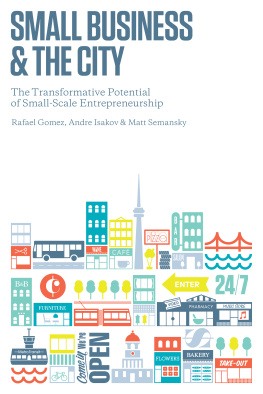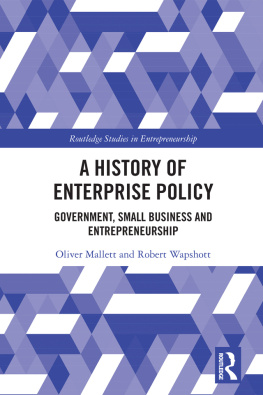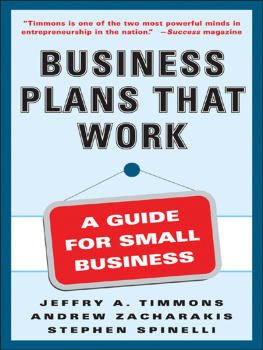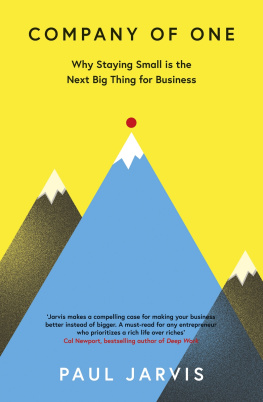University of Toronto Press 2015
Rotman-UTP Publishing
Toronto Buffalo London
www.utppublishing.com
Printed in the U.S.A
ISBN 978-1-4426-4362-8 (cloth)
ISBN 978-1-4426-1209-9 (paper)

Printed on acid-free, 100% post-consumer recycled paper with vegetable-based inks.
Library and Archives Canada Cataloguing in Publication
Gomez, Rafael, 1972-, author
Small business and the city : transformative potential of small-scale entrepreneurship / Rafael Gomez, Andre Isakov, Matt Semanksy.
(Rotman-UTP)
Includes bibliographical references and index.
ISBN 978-1-4426-4362-8 (bound).--ISBN 978-1-4426-1209-9 (pbk.)
1. Small business Canada. 2. Central business districts Canada. 3. Cities and towns Canada Growth. 4. Urban renewal Canada. 5. Community development, Urban Canada. I. Isakov, Andre, 1985-, author II. Semansky, Matt, 1976-, author III. Title.
HD62.7.G654 2015 658.02'20971 C2014-906733-X
University of Toronto Press acknowledges the financial assistance to its publishing program of the Canada Council for the Arts and the Ontario Arts Council, an agency of the Government of Ontario.

University of Toronto Press acknowledges the financial support of the Government of Canada through the Canada Book Fund for its publishing activities.
Rafael Gomez
Andre Isakov
Matt Semansky
Small Business and the City
The Transformative Potential of Small-Scale Entrepreneurship
UNIVERSITY OF TORONTO PRESS
Toronto Buffalo London
Foreword
Despite the fact that Canadian politicians routinely sing the praises of small and medium-sized enterprises, too often the focus of economic development efforts is on attracting at times with large tax breaks and subsidies the one firm, big sports franchise, or retailer that can transform a citys economic fortunes with jobs and growth. While nobody would deny the value of inward investment, there is always the danger of ignoring the true driver of growth: our base of small businesses. As urban economist Ed Glaeser notes, places with greater numbers of small, independent firms and abundant new start-ups experience faster income and employment growth than cities with one or two major employers.
Its also useful to remind readers that many of Canadas big corporate players, such as RIM, Rogers, and Bombardier, were once small businesses themselves. Bombardier evolved from a small manufacturer of Ski-Doos in 1930s Quebec into one of the worlds largest manufacturers of regional aircraft, mass transportation, and recreational vehicles. Meanwhile, Rogers Communications, founded by Edward S. Rogers, Sr, got its start as Radio Manufacturing Corporation Limited in 1925, selling radios with what at the time was cutting-edge vacuum tube technology. And RIM, at the dawn of mobile telephony in the 1990s, was just the dream of a Waterloo-based engineer and his business partner.
But its not just about economics. Our small businesses and the locations they occupy on our many streets and avenues form an integral part of this countrys social fabric and community spirit. We should not lose sight of Jane Jacobss prescient observations about how self-appointed Indeed, Jacobss ideas have been vividly extended right here in Toronto at the Martin Prosperity Institute in the work of Richard Florida and his colleagues, who have noted that cities tend to survive by acquiring and keeping human talent, which is in turn attracted by convenient and unique urban amenities. The capital and investment that follow can be traced back to human capital, which is itself determined by the quality of our main streets and city life.
My City, My Neighbourhood
This brings me to my own city of Toronto. Anyone searching for a case study substantiating Glaesers and Jacobss insights, need only look at the Kennedy Road Business Improvement Area (KBIA) and the Wexford Heights Business Improvement Area (WBIA), which straddle Kennedy Road and Lawrence Avenue East, respectively, two of the main thoroughfares in the ward of Scarborough Centre that I represent in the east end of Toronto. The community of Wexford, in particular, with its collection of small businesses, is the ultimate microcosm of Canadas economy, with virtually every sector represented, from financial and professional services to retail and manufacturing.
In a world seemingly dominated by chain stores and corporate fast-food giants, Lawrence Avenue East and Kennedy Road stand as unique bastions of independent entrepreneurialism and eclecticism. Defying mono-ethnic neighbourhood appellations, Lawrence East is at once the Middle East, the Far East, the Caribbean, Britain, southern Europe, and, for good measure, a bit of 1950s and early 1960s North America. Where else can one find Chinese food takeaways, Guyanese-Trinidadian curry shops, Lebanese bakeries, British pubs, and Greek delis on the same street block? The defining architectural form is the sometimes unfairly maligned strip mall. Unlike the vast parking-lot-dominated malls that would be built after the 1970s, Lawrence Avenues are almost sixty years old (built in the 1950s and early 1960s) with design features reminiscent of the early Las Vegas strip. Yet these are not stagnant period pieces but dynamic and evolving structures reflecting the ebbs and flows of demographic change and economic transformation: from burger joint to used-car outlet to frozen-food store to bicycle shop to post office to organic grocery store, and so it goes.
But economic growth doesnt happen in a vacuum; it takes vision and collective action. When I and a few local businesses began the process of forming the Wexford Heights BIA in the early 2000s, the long-term future of the strip was by no means a given. A lack of investment in both public and private infrastructure, fear of crime, and a lack of consensus and vision on how best to position the community within Toronto threatened to undermine its long-term success.
Through a series of BIA-led investments in the streetscape, marketing programs, street festivals, and community policing initiatives, the neighbourhood continues to be a lively hub of business and leisure activity, even garnering enhanced coverage in local media. A key element of this success is the number of new Canadians and immigrants who form the nucleus of entrepreneurs taking forward new business ventures in the ward. Undoubtedly, for Toronto and my ward, immigration is a vital demographic and economic lifeline.
But getting people and entrepreneurs to move to your city and community, as weve learned in Scarborough Centre, requires a focus on quality-of-life issues (good schools, parks, public safety) and amenities such as public transit. At a time when public finances are under threat, this is of course not an easy job, but one that nonetheless needs to be seen as a critical investment in future economic success. Bringing together public and private-sector players through BIAs is certainly one way of achieving this objective.
Small-Scale Entrepreneurial Success and the Dynamism of City Life
There is little question that a major part of the enduring vibrancy of Canadas major urban centres lies in the dynamism of its small firms. Whether its a filmmaker in Halifax, an independent auto-repair shop owner in Toronto, or a bed-and-breakfast operator in Vancouver, these varied and small entrepreneurs contribute not only to the strength of local economies through their positive impact on local supply chains and labour markets but also to community development through participation in BIAs and support for a myriad not-for-profit organizations and charities.















